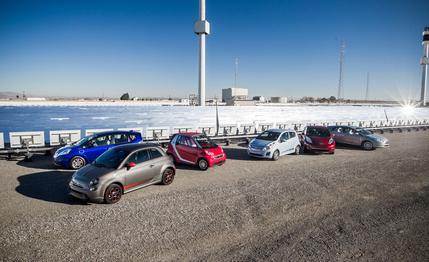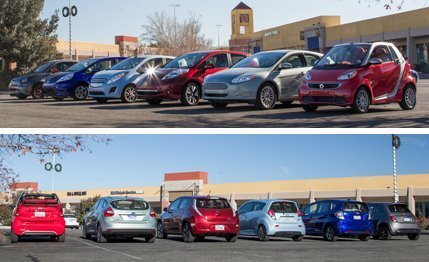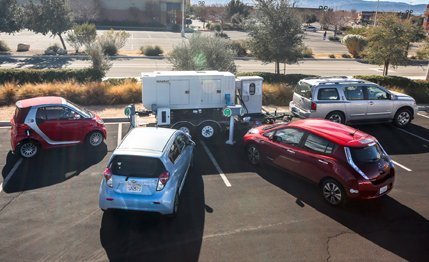 Comparison Tests
Comparison Tests
The makers of the cars you see here were dragged kicking, screaming, and, in some cases, litigating into eligibility for this test. If truth were ever told, then these automakers would undoubtedly say that they’d rather not be here at all, thank you very much; that all of their accumulated business acumen and experience rages against the absurdity of a $37,000 Ford Focus with a 64-mile driving range.
Yet, here they are, with six compacts at similarly loony prices, and utility that amounts to, as senior online editor Ron Sessions says, “cars with one-gallon gas tanks that take five hours to fill.” Why do they even exist? Because government simply will not get off the industry’s back.
The 20-acre, 5-megawatt eSolar power station in Lancaster, California, uses 24,000 computer-controlled mirrors (heliostats) to focus the desert sun onto two towers, which superheat water into steam to make enough turbine power to electrify 4000 homes.It started with a 1990 California mandate for automakers to sell electric vehicles there. Since then, the mandate has morphed—shocked into amendment by the realities of the marketplace, by the unpredictable march of technology, by a couple of lawsuits, and by furious negotiation. The mandate has spread, with seven Northeast states plus Oregon and Maryland also adopting California’s zero-emission-vehicle (ZEV) requirements.

The executive summary is that high-volume automakers must make ZEVs a growing percentage of their annual sales. Here’s a highly simplified example: Honda currently sells about 225,000 cars per year in California. In 2015, it has to sell 2250 EVs to meet the mandate. Assuming Honda’s annual sales volume stays the same, it would have to sell 22,000 EVs per year by 2025. Just in California. Add in the seven Northeast states currently signed on, which account for 40 percent of Honda’s total sales volume, and you’re looking at 80,000 Honda EV sales per year by 2025.
However, one thing you should know is that since lawsuits in 2002 by GM and other players, California has considerably altered the rule, expanding the definition of ZEVs and creating an elaborate system of vehicle rankings and carbon credits (Tesla does a good business selling its abundance of credits to other companies), which permits automakers to fulfill their ZEV requirement using a variety of means.
At the bottom and earning the fewest credits, or the “bronze” cars under California’s code, are extremely clean but conventionally powered gasoline cars. The “silver” and “silver-plus” vehicles are mostly hybrids and plug-in hybrids, while “gold” is bestowed on vehicles emitting absolutely zero tailpipe emissions, such as fuel-cell cars and the pure electrics you see here.

The fact is that automakers won’t see much gold from the golds, especially since most of these cars are available at heavily subsidized lease rates. And research shows more electric miles are being rolled up, car to car, by owners of plug-in hybrids than by pure EVs, which is not altering the industry’s current grim reality. Backed against a wall—though still pushing for changes—carmakers have begun rolling the assembly lines.
The result is our assortment of six small cars whose prices, only two of which begin under $30,000 before federal and state tax incentives, seem comical. And we haven’t even mentioned our logistical gymnastics to keep them charged [see below].
We staged the test in wintery-cold Lancaster, California, in the high Mojave Desert. The location was selected not for its scenery, climate, cuisine, or thriving hipster tech scene, but because it was close enough to our testing venue at the remote Hyundai proving grounds to be reached on a charge. We assembled only the most affordable electrics, excluding Tesla because its one vehicle is way expensive, and the Model S’s huge battery would have given it an unfair advantage. We asked Mitsubishi for an example of its electric car, the i-MiEV, but the company hadn’t yet received any updated-for-2014 models.
The government-mandated green initiative is here to stay, which is why we broke out the test gear. For better or worse, this collection of high-tech golds is the industry’s newest niche. We could only drive them about 100 miles over two days without risking a long walk, which gave us a lot of time to think. Here are the conclusions.